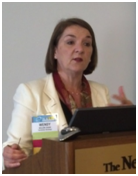Scanning job postings one can find thousands of ads with the statement: “Diverse candidates encouraged to apply.” Employers also include the phrase: “An EOE Employer,” indicating that they do not discriminate in hiring. This certainly has not always been the case. There are many examples of discriminatory want ads to share with you and, although some of them may seem amusing now, they were quite serious when they were published. There are many books and articles on how to avoid legal problems when writing and publishing a want ad, but that is not the purpose of this blog entry.
 I have heard variations on the following statement many, many times: “I cannot find any women who qualify for the job!” We can replace women with any other word describing a ‘diverse candidate’, meaning a person of color, a person with disabilities, et al. My response is always the same, “Where did you look?” This may sound flip, but it is an important and valid question to ask recruiters. For the past several years we have all been aware of recession conditions and high unemployment rates. There are many statistics showing that more women (of all races) than men have been earning college degrees in recent years.
I have heard variations on the following statement many, many times: “I cannot find any women who qualify for the job!” We can replace women with any other word describing a ‘diverse candidate’, meaning a person of color, a person with disabilities, et al. My response is always the same, “Where did you look?” This may sound flip, but it is an important and valid question to ask recruiters. For the past several years we have all been aware of recession conditions and high unemployment rates. There are many statistics showing that more women (of all races) than men have been earning college degrees in recent years.
(SOURCES: U.S. Department of Education, National Center for Education Statistics. (2012) http://nces.ed.gov/fastfacts/display.asp?id=72 The Rise of Women: The Gender Gap in Education and What It Means for American Schools, Russell Sage Foundation. http://www.russellsage.org/blog/rise-women-seven-charts-showing-womens-rapid-gains-educational-achievement)
There is still a gap in STEM (science, technology, engineering and math) fields between white males and everyone else, but that creates a great opportunity: organizations can sponsor academic scholarships for diverse students at high school and undergraduate levels and begin their recruitment in the sixth grade. The earlier an employer recruits candidates for employment, the more successful they will be in hiring a more diverse range of employees. Employees who are in obscure jobs are thrilled when they go out and speak at local high schools and middle schools with the response of the children. This helps with employee engagement, recruitment and marketing. The children go home and tell their parents how great the presentation was by employees from the “Acme Company” and the parents get a subliminal ad for that company’s products.
One way to create a viable ‘pipeline’ of diverse candidates in STEM industries is to have strong internship programs. This is a terrific way to find out how competent an employee is and for both the intern and employer to find out if they are a good cultural match. So, why is it so hard to hire ‘diverse candidates’?
Many job descriptions are ineffective. They do not tell the candidates what they need to know about your organization. A job posting needs to provide three sets of information:
▪ Is the job description up to date?
▪ When is the last time it has been updated and by who?
▪ Are the job listed duties both accurate and relevant?
Potential candidates will often be dissuaded from applying for a position where the job duties do not match their experience.
2. What are the job qualifications?
▪ Does the candidate really need experience in a particular industry to be able to successfully carry out their job duties?
▪ Does the candidate really need a master’s degree in business administration to schedule conferences?
People will not usually apply for jobs if they do not meet the requirements, such as a specific degree or industry experience.
3. What is it like working at your company?
▪ Do you know what the organizational culture is, particularly in the department or location where the selected candidate will be working? Is the workspace open or are there offices or cubicles?
▪ Is it a highly socialized environment or more isolated?
▪ Is the team interactive or independent?
▪ Are work hours flexible?
Savvy candidates will do research on your organization before applying for a job with you and if their information conflicts with what you state in your ad or website, they may not apply.
 |
| Philadelphia – During WWII |
Some of my clients have told me that they are successful at attracting and recruiting ‘diverse candidates,’ but they are not successful at getting them hired. ‘Diverse candidates’ are getting rejected at the interview phase of the process. Recruitment professionals who have pre-screened and pre-interviewed candidates are often baffled as to why their candidates are not being hired. There seems to be a challenge developing interview questions that focus on the Bona Fide Occupational Qualifications of a particular position and developing interviewers with a high level of cultural competence. Very few interviewers who I have spoken with are aware of Transferable Skills and their value. For example: If someone is great at planning a meal for 20 people, they can probably handle organizing board meetings or employee events. The skills are the same they are just being applied differently based on the specific need. Another great opportunity for employers to increase the diversity at their organizations is to provide transferable skills workshops for their human resource professionals and any employees who are part of their selection and hiring teams.
Even employers who are committed to increasing the diversity and inclusion at their organizations are sometimes stymied as to how to achieve those goals. Sometimes this results in hiring of ‘diverse candidates’ who may not be fully competent for the position. This creates a couple problems: first, the new hires are set up for failure if they are not fully qualified for the position; second, this reinforces the urban myths surrounding affirmative action. So, I urge you to hire only the most highly qualified candidates for every position that you are filling. I also urge you to reassess the jobs that you are seeking to fill, what they entail, and what someone really needs to know in order to do them well.
Employers invest a great deal of money in the recruitment and hiring process. Fees for search firms are in the many thousands of dollars for each position, and the salaries of HR and other staff when prorated for each new hire brings the investment to quite a high sum. So, how sound is your investment? Are you selecting and hiring the best candidate for the job? Is the job being described in the most effective and honest way possible? Have key members of the selection team been developed to be as competent as possible? If you are confident that the answer to these three questions is yes, BRAVO! If not, isn’t it time to reassess your process?
Onward!
~ Wendy
www.inclusionstrategy.com
wendy@inclusionstrategy.com
Please let me know what you think of this entry.
If you cannot comment directly on this blog, please do so via twitter, Facebook, LinkedIn, or email me.
JSrAn1kUmKUSDvFUFYPXRjTNCktD3prT2KrtnaKoSwdujD0Fbtt21J+Jr0KN9FLMfS34MKUZUl/x+g3JqaPXUEvxdw2r2EYTH0k9HdMVqWVXooRTzKfHVa/pmka+g+XEv/VSDF93+/3JM4CayZoHEd617IoCvHHpJFibi/JMIy6rlnvG2Uq2zAM3/fFH5NGiqE5h+ja8Hk09G+aFI9JI8VQFrFeGD7jlL7GyuBaw2ZopBju2WOXgbusmP7WxXEs+Jh0Ucw4jrs+jFPAHcunz0o6jiP4pHRRzO0oWZbFffeYnIaVMSg06KKYO9orMs6DPo9tCM+00kUxTJGoSyLyIJmiMoKTZnRRDOWgwAsjWJBA2ZVtiG1/6FaMJgg+RUQ9ygojos5bMVogPpOMyfgV2QFvxWiBeMU/kyFIUxX6DV0Ug5ulJ7IsSxnB0505jqvQAY4GlBlM4QmRyl9dFCOdc7U7SZmtSv91pmnyf4v4herJiUptxOOwGKaCV+5+3lsx6pE1ipe+7MEQSEneilGPrIMFmMpFuG1t+YrJ89w7FqIRsN8Dlo642Yuhb8Y2BPpRJCuGqVZDFsTU2vGXwY2s8QuUhxhgns8n37dIVgx92l0iAADCDzsJ4tHeCaZsLvf3ylQMhHC/O7sC0YhTciUcSKm9xbBWjPC59DIVoypuS+zdUnIlHEgcI8ValcbnYMtUDP2ZaXIhmv1KroQDKR0hfL+auJtvf4XEy1Xl0BJrV8/iXYuXanP/ar65MtIUo8qIMb6U4NPXi6iF70X/BlPYly8OJE0xCovobNteXg9TAFQhglW3M5iyaXytC9IUo7ajcWn2qzKqWJGrGKa6Kr5OFGmKUTvrcDlomSkAqhC5imF6T/jCvtIUo/adXnocTAFQhchVzOfx7pvwtWBeZI1Zvi5K8hUc/FzFqLVjHo/H7HqGYVB4PfT8XMVwt6jh/DPf//1kafyewsGW612fSTFM77TneXmez3ogxnGs6zqOY75TCJahsFO4S3IjeGdSDKIIOJqmGccxTTqjqirW4SDLBM0p+hNkDTTEnEwx68EA3/dZC0EAAPQb1rI+/hTd/3IPFjyZYlbeaZF8W9M0lPvU0orUP7sk9wikkymGaMqYpilelTgMA00R61KX+k9Kk1gfg06nGETK5mzKBUJY1zXuUsvzfMXbbNt2PdO2vAVMYzKUQEyKccNk7GuhmFncbH3JreuaaN4GQfDN4hnHcWXZME1z6WN/29Gezyd27D8bK5WMoJZ4/tH5FIP+Xeq78uDXzWTLslbmD1RV9a1JdlnzgYPRruvGcZxlGQBgZRlbGsv4/NJd7SGJB5MwZex1UUzf9/hxrqy3NGlC27ZXfKv3+03coZY96Exv8NIUm/4J756v10t6YFDiiVlM9TF8/fq7dLgBAEzTXGnupfR91je1YRiWrQvEjYmJ2QcS/wZCWJZlGIZSjoJKkkTkgj9hmk+gOHc9AwDgOA7xtOfPlf/xeJRliec5VFU1i77QPP6l5SEYE5vd9PU/HoahLEvBScSy3CXWVJriiioixPDupBjinZptWDSPvygKiQ9gZrJQ/q/3+x3HMd8IElnu0vv9ZvpevkZaBX3XuEnC87xvFsbnnkXZxV7X9bRBCB7yPDNTmP7vOI55nnPkxaRMA6E/OR3Dtxir6dR3HGfFQfjcm+jfPwDA9IqL9L7PdkaOTxjHsSgKJvdKSj6SteyQL7KqRjHr1zq71/TvX9d1WDTLchl6ZtY09+cghMqypNSNlFwBU5GvoUOHmxSWmzFTuKLve/yQuOtOZkEwvg+ZwPvUpn3D3Tf/CasBzhc51E4xS9+HdfHEouEeDji7AL4PmTEMQ5qmK664lHNsmOxubnNbL8UQD7vmMOn7vn88Hnzm5CyZx/EJ34AQrsy+WFkUIYSbMRvW0g6+gC/STTHEtA7f0K++7/nMyVnBMscnrNM0DTEyS4yO9H2Pd8nNB8zqKHEfm6ORYogLjCHsLbMyq/LZ6VuyLJv92NmLAQD4XJA2F1qmOgdDoGJJI8WsZNGCIJCY4F1n9rLu90UQwk/vZhoBVJblMnW1af6zznriTn/qopjNmlzHcbIsO2CxmZXU7P11dV1PEb84joneOM08Kabwz+nn+UII6e183Icgt83nk1mJz07fMtE0zWZRy6Ylx5pREnHmtVAM3xyG5/OZZRkx2SkC9oQn5H44BgCQpmkQBJSp780QNqvZKxIwVK8Y8R4R27ajKCqKQmJpklzwqQtxHPP18m3+LtbSQZGkhGLFMO1HNJim6XlekiRVVXEPUhf/UdNhHJ7n8TXsTdAYMaxFXiKJT8WKOaCu9vl8BkGAtxhciCPF7RqGAQAws8THcZQ+sUC6ESNy8AlSqxhV4xdc110azn3fzw7qybJspq22bX3f9zxvsj8sy1rWXLZtK7iufLIZODnSiEFqFaOwmci27ZnJPAzD0gBfaouohiiKZtoahkFW1/emV8i6Tgu2jylTzDAMUopkuTFNc7k8LO++ZVmzWwwhXGaJH4/H0muj7+b8Bs1BOkxGjGVZgpuyMsVo0ka/zPAVRbGU8tLNXtorpmkuY/kQQpEZjpvF26xGDPcBFhPKFKPkBAMiyxTEZznf55/NXIymaZZ/RhxIUJYln0u4WVjJOrxNvKNZmWKYOmv2Zmmv4HqJ2Z89Ho+Zx973/XKHWm5kCCEIIUcwZtOIYbKWxLckpFAxrPdubyht4aX1862x9/V6LR/PMmW9Ao0Rw5ROEt+SkCrF6DnZhdIWNkgOKtH6Wa5JCKH3+01ZXrn5gFnbTaRMUFOjGJ3HGlLawp7nzewV4ugJ0zSJARWaQN+mEcNUEyPr/FJlu5LOs4AobWHiRkY0LHzfXwbmN4ebbMbymWxBWVlVgmLatk3TtCiK9TEIgmg+1pDSFiYuIWVZLtck27aXm8I4jt/ib5uxfNYtSdajJK8xbdt+7rU4vYezM7hNWryHT/8JzZS2sEGK+XZdR1xEiQXexEDfZiz/gHFURNZ2paqq1vcOx3E8z4uiCI+XAgAwVatovswYLLbwck0ahoHoTj+fz6U5vNzONgsSju+5xGzbMd8mSa1gWZbneWEY4pReVVUAAOJtOsWQZkpb2LKs5b5DXAksyyJatXVdT9bS+irONK1Nls2LobV8AQCyTix6PB7TUdVaxfFWoLSFDZKBCQAgZpeiKFrKAmcVNo0YpuVZ1gnsGDZfqe/71+slMZV/IihtYYOUT/iWXfo2Yme9FmwcR/owoG3bctswOL1rXM8st3xOf+htYWLs7lvAl7XpkymJK3deMBKPx9R1/aOkQ28LMxVbPZ/PI7v4RJAWwQMAvF4vneNyEqG0hQ3SK/4tJWlZltxTLXZil1mbRVGEYaiPuWPb9mRr41jAN3BRJk05N70t7Hne0sL9FrhbhnZ0Y98sAYSwaRr8JPZzpHFYaHLmwf8QDzO+328AQJ7naZqGYThbG+ht4aUBhL5PJX48Htq20aDj80r4GeDp3J7nMe1i+O1/vV6TMvZLYmz+BPwmLFME32xhYj7hWx6bWM6nCeo73DDgO0pkIci3TSeO43/++efz1/3111+//fYb8Y9//fXXv//++/OPddiwdFHMlcBP9/fff//ll1/oV1B68C6M03x4bv6RftatGH7GcQQAFEWBDTXBOdDiYLs+z3Ppveif/F8xOqx4moP1kSSJeG/sAeBu4rqu94r54nyhxI8+O13XVVWF14+z5L++4ft+URRSLMJ/7UpRFHme92N1g5cQ7gkMp8B13TzPReyefylmHEfsGeIDJqSMPtcZHGsJw/DsSwgHnufxndIzt3wn0RiGYZpmGIZVVV3DxMHTGLIsC8PwFHU5B+A4TlEUTM+X7CvNwgmmaQZBUBSFqoksfLzf7ynirI+hin3jiWlSySc4vjyxtxdm2zZ9Dc1X75pY3ow/PQzDvV04DqZochRFCh1dXC/2WckqJV8x0bbtFHGetCUlAew4Dk0qdC0e03Xd5gb/fD6n8xcPs3twIASfYKtwi8HiSJIE910oN/vwbKyyLEXiQ5sH2W9E8DiGLs1SxPhuTtD/8kkTGOVVnq7r4h91rsTFtPTGcUypoW9lyBiqmG/XdcoDmgfjOI7v+7isXbf9VxBs/m9O+iR25SGmLEFVVfrYj9LBSwjeXq/hG9LQtm2SJN+29cfjsVxNDzrVTkM+JSLvEZyV6XTdWcnO8uBxzlPtxA9gPRjc1vl6vcqyvNguI526rj8PTHAc53OlEcpd4wNY9VxycKWm2sG+pwZCmGUZfrifh1XJqXbAA7EVSgfr4/V6YddMf0MEBwg+wVUTM9dShwaDqqpc153OhJZcHwMhrOsa1wPspw/XdfH6gccGyP0JEvkcHo5rzrlfKvzMsO+mZMmcSk73rajq+x5HJ4MgoA+oLEv/p+CpzosHzltN4th19iyOvMsqYGDirsHjZxgGHfJWruumaXqYdG7FMPC5imjYy+f7/gE9crdiNui6riiK1+t1lgIJx3E2B+iJcCuGQNu2eZ4HQXDefvLn87lT2EkXxeCUp5LYGnZ08zyPougsCwkle5xBp4tiEEJFURiGYdt2HMd1Xe9nyk2VVkEQXL5e81tCkRuNFIMQmmUecGgfO9h1XdOHtrqum/4Sh0NwiOjgzIbneTiIgqMDf/zxB/dH/fnnn9NvwbXr9L+FeJ4UN3op5iyT8Yi4rhuGITH7/W2KIg2maa5Ysvggsc3KslluSAS9FIMQ6vteQ8eVyPP5xHHndfPr26RWGoiHYqzTtm1ZllEUzb70+XxKiX9qpxiE0DAMeibGHcfBbar0qYmqqriDv7ZtC44FmWb54A+M41jk0zA6KgYj/YhODizLwoYIR1JQ8OA/ucbHlIg+8flKNHRdd3x7ouu6cRwLnp4teN6fdAcHM46j+CwjrRWDAQDseuCb4zi4aahpGvHnBCEUWVpM05Q7flc6J1AMZhiGqqqiKBLP+bmuGwSB9JLecRyzLBMJExOPJ9WN0yjmk/f7PU1dwEURS+tyaj38bILZKSoopfxZ/5mJmFMqRh/6vk+SRFArUgzSw7gVwwOEsCgKcavcNM0kSU6xtEzcimHg/X5nWSYrKh0EwYl6KyduxWzQdR2eMSOxys51XZ3Lk9e5lGKGYcjzHBeNz5KXNG7z1O+dZRnOXEqvj3Fd9xSj5Fe4lGIwXdd9NmhpwgW0grmgYjAQQk0afsMwPO8etOSyiplQ1X3num5RFDq0qMnl+oqZAPuf5zONfzujE0TJD1LMxFQDIEU90wyAE0XhRPiJirkR4VbMDRv/AfF+7UkqI3amAAAAAElFTkSuQmCC” width=”198″> People are usually thrilled when they start a new job. The ‘new job feeling’ is not unlike the ‘new date feeling’ or ‘the new car feeling’. It takes most of us a while to decide whether the date will become a mate and if the car is a keeper or a lemon.
Most new jobs have a three month ‘honeymoon’ period, although many people begin to feel disenchanted much sooner than that. On-boarding is the experience that a new employee has when they first come ‘on board’ at an organization. There are many studies that have demonstrated how critical on-boarding is. Large organizations invest billions of dollars in the on-boarding process for orientation sessions, training, lunches, dinners, etc. The success of these investments varies wildly and can determine how long an employee will stay with an organization, how productive and engaged they will be while they are there, and why they will leave.
Three Exclusive On-boarding Experiences:
1. A woman from India was recruited for a managerial IT position by a Fortune 50 company located in a rural area of a Southern state in the U.S.. She was a Hindu and a vegetarian. She expressed serious concern about becoming acclimated to her new culture as she had no idea where she might go to worship. The meals provided at the new hire orientation that she attended were inedible as every day only ham and egg on a biscuit was provided for breakfast. It was difficult for her to even find a meatless salad for lunch. She would eat at home early each morning and then not eat again until dinner each evening. Her cultural differences were never considered when she was hired and as a result she resigned within a month of her first day of employment.
This company could have saved a great deal of money, frustration and negative feelings if they had learned about their new employee’s culture during the hiring process and had provided cultural competency and inclusion training to those responsible for the orientation sessions and her on-boarding.
2. During a new hire orientation presentation, a representative of an organization’s Diversity Department pulled up a chair and sat down with his legs spread, one foot straddling his other knee such that the bottom of his shoe was facing the audience of new employees. Then he stood and put one foot on the chair. A few of the participants became visibly uncomfortable and were silent during the Q&A segment of the session. The presenter was at a loss as to the cause for the employees’ shift in engagement.
Even diversity professionals can make cultural gaffs if they are not provided with effective cultural competency education. Showing someone the bottom of your shoe, the lowest and dirtiest part of your body, is considered an insulting message in many Arabic countries. Putting your foot on a chair is considered insulting in some Asian cultures. The presenter thought that he was creating a relaxed atmosphere by using these gestures, but the result had the exact opposite impact. Intent vs. impact is a familiar concept in the field of discrimination that is often overlooked in the ‘softer’ field of diversity, sometimes with serious results.
3. A new manager orientation session included ‘partner’ interviews and introductions. The participants were paired-up and instructed to interview each other, asking 5 key questions, including the name of their favorite sports team. One interviewee told her partner that she was not interested in sports. He asked her where she was from and she replied, “New York City.” When he introduced her as a ‘Yankee Fan’ several other participants booed. She was highly embarrassed and complained to the facilitator at the end of the session who told her that she was overreacting and should not take the booing seriously.
Awareness of regionalism, including the impact of sports rivalries, is an important competency for trainers, especially those trusted to facilitate new hire orientation sessions. A new employee’s relationships are established during their on-boarding and any reinforcement of negative stereotypes can impact their success long afterward by creating barriers in those relationships.
How likely are these valuable new hires to become loyal, long term employees at the organizations described above, based on their on-boarding experiences? People need to be invited or included to really feel that they belong as part of an organization and that invitation must go beyond a job offer. Behaving in an inclusive manner is not necessarily intuitive, as we see with the diversity professional described above. Employees, especially supervisors, managers, and trainers need to be developed to be inclusive leaders with high levels of cultural competency if they are expected to know how to effectively create inclusive on-boarding experiences for new employees.
Why Does This Matter?
As the economy recovers, those who have not felt truly invited to become a part of a successful, innovative team will begin to seek out employers who will make them feel welcomed. Those employers understand that a high level of organizational cultural competency is required if they are to succeed and earn profits. Job seekers, especially ‘millennials’, are doing in-depth research on employers before accepting job offers and those who have negative on-boarding experiences are posting those experiences online. So, after investing a great deal of money in recruitment, hiring and on-boarding high potential employees, are you confident that they are being on-boarded inclusively? If not, isn’t it a good time to make that happen?
Onward!
~ Wendy
Let me know what you think.

















